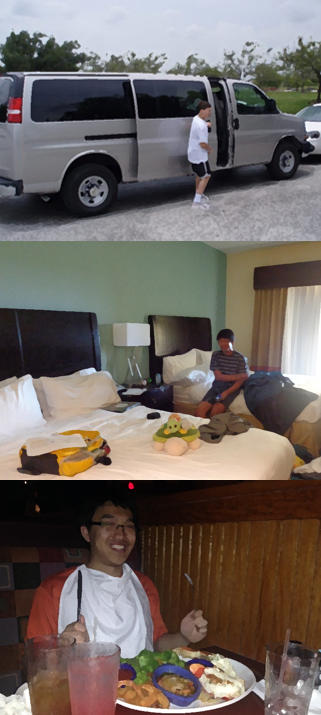WC '15 Contest 1 J4 - Trip Budgeting
View as PDFWoburn Challenge 2015-16 Round 1 - Junior Division

The PEG trip at the end of the school year is a long-lasting tradition of the club. The leaders usually decide on three teams (junior, intermediate, and senior) based on whom they find to be most attentive and hard-working throughout the years. Then, the deserving teams are taken to some place in the USA (a different city every year!) where they will compete, and most probably dominate, in the American Computer Science League (ACSL) All-Star competition. The trip will then consist of several action-packed days of competing, dining, frolicking, and touring the local attractions. While most PEG students who are selected to go are simply enlightened by the fantastic opportunity, few of them are aware of the rigorous planning and budgeting that takes place behind the scenes.
Budgeting is a complex task. We must account for transportation, hotel,
food, and most importantly – attractions. Choices must be made in each
of these categories with consideration for how much money is going to be
spent, and how exciting the trip is expected to be. To make each trip
memorable enough for the PEG history books, the PEG leaders would like
this year's trip to have at least an excitement level of
units. Funding has always been a complicated
matter due to Woburn's Student Activity Council (SAC). The SAC is
willing to help the club satisfy its minimal excitement level, provided
that it is done in the cheapest way possible. The cost and excitement of
the trip will be calculated with the following rules:
- The base costs of transportation, hotel, and food in dollars are
respectively
,
, and
.
- There are
attractions numbered from
to
. The team can attend each attraction at most once.
- Each attraction has an
,
,
, and
value associated with it
.
- If attended, the
-th attraction (for
) will contribute
units of excitement to the overall trip.
- By going to a particular attraction, money may be saved or extra money may be spent. For instance, the team might have to pay extra transportation costs to reach the event. The team might also have to pick a more expensive hotel in order to be close enough to attend it. Conversely, many attractions provide free food, so the team might actually save money on food.
- By choosing attraction
, the team must be prepared to also pay an additional
dollars for transportation on top of
. That is, the overall transportation cost is the sum of the base transportation cost and the transportation costs incurred across all of the attractions they decide to visit.
- Each attraction has an associated hotel nearby that costs
dollars to stay at. Since the team will not be attending more than one hotel, we have to prepare for the worst and assume that the overall hotel cost for the entire trip will be the maximum of
and
across all of the attractions that the team eventually decides to attend.
- By choosing attraction
, the team will actually save
dollars on food because it will be provided at the venue. That is, the overall food cost will be the base food cost
subtract the
for each attraction
that was attended. The base food cost cannot go below zero – after
has been reduced to zero, attending additional attractions will have no effect on the nonexistent overall food cost.
- Each attraction has an
- The total cost of the trip is equal to the sum of the overall costs of transportation, hotel, and food respectively.
- The excitement of the trip is equal to the sum of
across all of the attractions that the team decides to attend.
Given this, please help the PEG leaders determine the minimum possible
total cost that will produce at least units of excitement for
the overall trip. It is guaranteed that this is possible.
Input Specification
Line will contain four space-separated integers in the following
order:
,
,
, and
.
Line will contain a single integer
.
There will be lines to follow. The
-th of these lines (for
) will contain four space-separated integers:
,
,
, and
.
Output Specification
Output a single integer – the minimum cost (in dollars) required to
achieve at least units of excitement on the trip.
Sample Input
50 2000 20000 4000
5
30 300 20000 400
40 500 30000 2000
10 100 15000 800
30 500 11000 1000
20 400 20000 500Sample Output
24600Explanation
The team wants to achieve a minimum of units of excitement, and has
given the five attractions with excitement ratings of
,
,
,
,
and
respectively. By choosing every attraction except for number
,
the team is actually able to achieve
units of excitement at a cost of
dollars. The costs are calculated as follows:
- Transportation costs
dollars.
- The most expensive hotel across all of the attractions being
attended costs
dollars.
- Food was originally going to cost
dollars, but
dollars were saved by eating at the venues of the attractions.
Thus, the total cost of the trip is
dollars. In fact, this is the best possible answer.
Comments